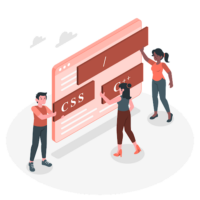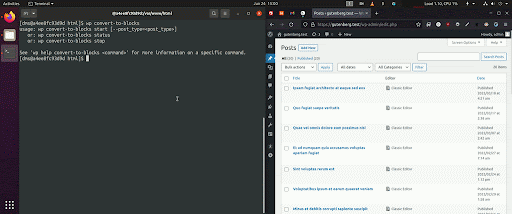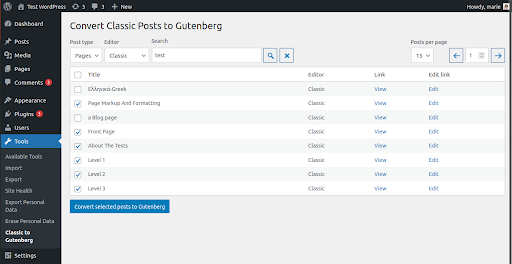Converting Class Post to Block Post
Are you ready to embrace the modern and dynamic features of the Gutenberg block editor but unsure how to migrate your existing Classic Editor posts? Fear not, as we guide you through a smooth and seamless transition, ensuring that your content not only retains its essence but also harnesses the power of the Gutenberg blocks.
Our experience guarantees quality, from optimising WordPress for Core Web Vitals to creating content more efficiently with Gutenberg.
Understanding Class-Based vs. Block-Based Posts
Before delving into the conversion process, it’s essential to understand the fundamental differences between class-based and block-based posts.


Class-Based Posts
Class-based posts follow a more structured and linear format. They are often characterised by a hierarchical organisation, with a clear distinction between headings, subheadings, and paragraphs. For many years, developers have relied on this conventional method because it offers a straightforward way to present information.
Block-Based Posts
On the other hand, block-based posts break content into modular blocks, each serving a specific purpose. These blocks can include paragraphs, images, videos, quotes, and more. With the ability to design and customise each section independently, the block-based approach offers developers a more flexible and visually appealing way to create content.
Why Should You Make the Changeover?

-
Visual Flexibility
Block-based posts offer unparalleled visual flexibility. With the ability to customise each block individually, bloggers can create visually stunning and engaging content that captures the reader’s attention.
-
Ease of Editing
You can move, rearrange, and modify individual blocks without affecting the overall structure. This makes it easy to experiment with different layouts and designs until you find the perfect arrangement.


-
Improved User Experience
The modular nature of block-based posts enhances the overall user experience. Readers can navigate through content more intuitively, and the visually appealing design keeps them engaged from start to finish.
Converting Class Post to Block Post

-
Content Breakdown
Start by breaking down your class-based content into distinct sections. Identify key headings, paragraphs, images, and any other elements that constitute your post.
-
Block Identification
Map each section of your content to a corresponding block in the block-based format. For example, a heading becomes a heading block, a paragraph becomes a paragraph block, and so on. This step helps you visualise how your content will translate into the new format.


-
Media Integration
Take advantage of the block-based format to enhance your content with multimedia elements. Insert image blocks, video blocks, and other relevant media to create a more engaging and visually appealing post.
-
Customisation
Embrace the customisation options provided by the block-based editor. Experiment with different colors, fonts, and layouts for each block to achieve the desired look and feel.


-
Consistency Check
Ensure that the transition doesn’t compromise the consistency and flow of your content. Pay attention to the overall structure and make adjustments as needed to maintain a seamless reading experience.
-
Mobile Responsiveness
Test your block-based post on various devices to ensure optimal mobile responsiveness. Block-based editors are designed to adapt to different screen sizes, but it’s essential to verify that your content looks great on both desktop and mobile platforms.

Try to Convert To Block Plugin
Note: Please back-up your database before running the converter!
Convert To Blocks
The Convert to Blocks plugin on WordPress.org streamlines the process of transitioning from classic WordPress content to the block editor. This tool facilitates the conversion, making it easy to update existing posts and pages.
Convert Classic Posts to Gutenberg
With the help of Classic Posts to Gutenberg, you can easily update your old traditional content and ensure a seamless transition to the cutting-edge Gutenberg block editor. Experience the enhanced features and modern capabilities of Gutenberg without the hassle.
Troubleshooting Tips
If you encounter any issues during the conversion process, consider the following troubleshooting tips:
Back-Up Your Content: Before making any significant changes, always back up your content to avoid data loss.
Plugin Compatibility: Check for plugin compatibility with Gutenberg. Some plugins may need updates to integrate with the block editor seamlessly.
Preview Your Posts: Use the preview function to ensure that your posts appear as intended before publishing.
Conclusion
The transition from class-based to block-based posts marks a positive evolution in the world of content creation. You can now leverage the visual flexibility, ease of editing, and improved user experience offered by block-based formats.
Accept the power of block-based editing and allow your imagination to direct how your web presence develops in the future.
Submit a Review Today!





